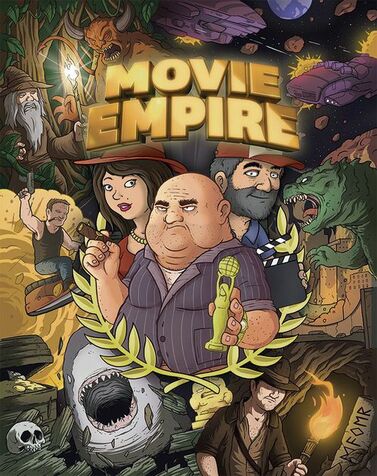 Full disclosure: I received a review copy of Movie Empire from The Dice Tower. What is this game about? Movie Empire is a worker placement game about becoming the best movie producer, as indicated by getting the most victory points. Throughout the game, you'll choose scripts, acquire and arrange the right cards to bring those scripts to life, add stars, and produce movies—ideally trendy ones—in various world markets. You'll also vie for the favor of your boss, Mr. Grumpy, whose feelings about you determine your budget and your ability to have more than one film in production at a time. During each turn of the game, you'll receive your budgeted money from Mr. Grumpy (better hope he likes you), then place your workers in various spaces on the board. Your ultimate goal is to turn your scripts into movies you can produce. To get points for your scripts, you'll need the right combination of production cards of various colors. But if none of the cards you need for your script are available on the market, you can take other actions that include sucking up to Mr. Grumpy, getting more money, or drawing from the deck of production cards. Interestingly, while meeting all of the requirements of a script can earn you big points, you only need one blue production card to actually produce your film, which may lead you to go for fewer but faster points instead. In addition to getting points for scripts, you can also get points for producing movies that are "trendy" in a given round, so you might be tempted to rush your action movie to market in a bid for a quick score. In the multiplayer game, you can also choose to play with "Black Dossiers" which add a pretty vicious "take that" element to the game. How does it play solo? Movie Empire comes with a solo opponent called Archibald Leech, who plays with a combination of his own decks of cards and with the main player board. He comes with a deck of cards that will determine his actions, as well as a logical set of priorities if he can't do what is specified on his AI card. He also has a built-in catchup mechanism—he uses only two workers if he is ahead of you, but three if he is behind. 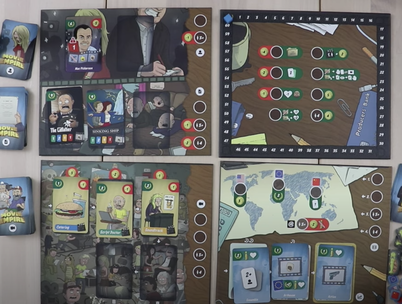 Overall Thoughts Movie Empire had some good ideas in it, but it did not impress me overall. It is clear that the people who made it love movies, and they put a lot of work into the aesthetic of the game—the art is pretty cool (especially if you love watching inappropriate cartoons aimed at adults), and several of the boards even have alternate art on the back. And I liked that enough thought was put into Archibald to make solo mode an actual challenge. But in the end, this game is bloated. There are so many ideas floating around in it, including multiple game modes that you can add and remove, that the game doesn't quite flow. There are a lot of actions you could take, but they don't feel sharp or satisfying. Instead, it feels like Movie Empire was stitched together from every decent idea its design team had, without any of the careful paring down that might have made it into a stronger game. There are also a few technical problems that inhibited my experience of playing Movie Empire. The first is the rulebook, which is at times unclear. It reads like work from an author who knows exactly what he intends, but doesn't always step back from the work enough to make those intentions accessible to others. There is also a bit too much resource squeeze when it comes to the production cards. I mentioned above that you can produce a movie as long as you have a single blue production card. However, you also cannot produce a movie without one. That means that if one is not out on the market (or if your opponent gets it first), you may find yourself stuck and unable to get your movies made and on the market. That level of chokeout, in my opinion, takes a game from "competitive" to "not fun." Do I recommend it? No. Movie Empire has ideas with potential, but it does not come together to form a compelling whole. Overall Rating: 2 stars Rating Scale: 5 stars — I love it! 4 stars — I really like it. 3 stars — I like it. 2 stars — It was okay. 1 star — Meh.
0 Comments
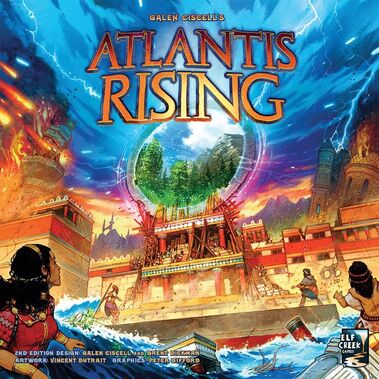 Full disclosure: I received a review copy of Atlantis Rising from Elf Creek Games. What is this game about? Atlantis Rising is a cooperative worker placement game in which Atlantis is sinking, and you are trying to escape. To get away, you will need to salvage resources, build components, and ultimately activate a power core that will allow your people to flee their drowning homeland. The resources you need stretch out from the island's center like the spokes of a wheel. In the mountains, you can get precious ore, but you'll need to go to the forges to process it into Atlanteum, your society's most impressive metallurgical development. Other parts of your island offer gold, crystals, spaces to recruit more workers, and a library where you can discover helpful skills and artifacts to aid you. Each turn, players will place their leaders and workers on tiles they hope will yield good results. To get resources, you'll need to roll a die and hit a certain minimum number to succeed—and the spaces with the highest success rate are furthest from the island's center. This reality is the main tension in the game, because after you place your workers, but before they can take actions, you must suffer misfortunes by overturning cards that will cause various parts of your island to sink. If a worker is at the edge of the forest and the forest sinks, then that worker returns home empty-handed. However, works placed nearer the island's center may still fail because they don't get the die rolls they need. And the clock is ticking. There are, however, ways to modify your die rolls. You'll be able to acquire "mystic energy" throughout the game that will allow you to add to your roll's total. Various cards from the library will be able to help you. And each player's leader has a special ability that should be used to the greatest possible effect during the game. As you build components leading up to the activation of the power core, you'll get additional bonuses and even new action spaces to exploit. But to win, you'll need to make the most of everything you get. How does it play solo? Atlantis Rising has a dedicated solo mode, but is also a cooperative game. That means that a solo player has choices when deciding how to play. In a purely single-player game, you'll have access to more workers at the beginning of the game, as well as to a special worker called the Automaton that takes no actions of its own, but does contribute to die rolls in areas where it is placed. You'll also have a special leader called "The Hologram," which rotates through special powers available in the multiplayer game and lends you a different one each turn. In a two player game, you control two sets of workers yourself and have access to the Hologram, but not the Automaton. It's also possible to just play a three (or more?)-player game by yourself, controlling three different sets of workers but without the Hologram. 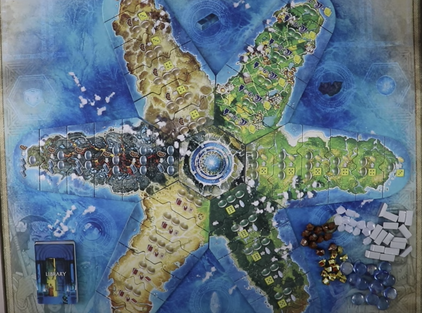 The playmat is not included with the base game. The playmat is not included with the base game. Overall Thoughts Atlantis Rising is an excellent game, and I was really impressed with it. Its production values are stellar with or without the deluxe components, and everything works well together, from the components, to the art, to the clean and clear layout of the rulebook. Normally I don't pay much attention to art or components, because gameplay is king, but the quality of Atlantis Rising is exceptional enough to grab even my attention. Most importantly, the production values in Atlantis Rising support riveting gameplay. The entire game is tense and dramatic, as you hope for high rolls and wring your hands over the most recent chunk of your island to sink into the sea. You'll be thinking pretty hard about which workers to place where, how to use your leader powers, and how to make the most of cards you got from the library. There's a lot to think about and a lot to do in this game, and events will turn out differently each time you play. If you hate submitting yourself to a roll of the dice, however, Atlantis Rising might really frustrate you. You need good die rolls to get the resources you need, and you might not get them, especially early on. That means you can lose actions, or even have multiple stages of your plan go awry after you didn't get the right resources. While most of my games of Atlantis Rising have been delightful nail biters, particularly unlucky games can be very frustrating. If you don't like this kind of gameplay, Atlantis Rising is not your kind of game. However, I found that with the various player powers and opportunities to adjust my die rolls, the game was great fun for me overall. I'd also like to note that, while I appreciate that Atlantis Rising has a dedicated solo mode, I actually do not recommend it over multi-handed play with two or three leaders. Two-player games are great because you have two sets of workers plus the hologram, while three-player games are also enjoyable and more like the "standard" game. I found that pure solo eliminated the fun of having different leaders cooperate by lending their powers to each other and by combining their resources to build components and, ultimately, the power core. Do I recommend it? Yes, I definitely recommend Atlantis Rising. It's exciting, fun, and immersive as a solo game, and I'm looking forward to playing it with my group when it's safe to have game day again. Overall Rating: 4.5 stars 5 stars — I love it. 4 stars — I really like it. 3 stars — I like it. 2 stars — It's okay. 1 star — Meh. 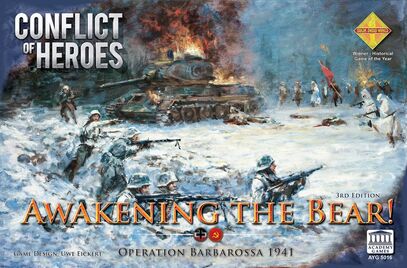 Full disclosure: I received a review copy of Conflict of Heroes: Awakening the Bear from Academy Games. What is this game about? Conflict of Heroes: Awakening the Bear is an entry-level hex and counter game set on the Eastern Front during WWII. It can be played two-player or solo, and it pits the Russians and Germans against each other in a number of scenarios. These scenarios increase in complexity over time, and can eventually feature hidden enemies, epic tank battles, and more. Each mission has a different objective, but common themes include destroying enemy units and controlling key locations on the map. The tension in Conflict of Heroes comes from the limited actions that units are able to take. Each player can take only one action per turn, and after that action, they must roll a "spent check." For a simple action, like moving, you don't have to roll a very high value, so you are more likely to pass a check and be able to activate that unit again during the round. If you attack, your odds of a unit being spent are a lot higher. But because you're rolling a die, you never quite know what is going to happen, and that can lead to serious excitement. A spent unit is also sometimes still able to perform an action—if that is how a player chooses to use their CAPs, or Command Action Points, which they have a limited number of each turn. (CAPs can also be used to modify die rolls.) Play continues until both sides pass, but with both spent checks and CAPs in play, you'll need to keep a close eye on your opponent and try not to leave yourself vulnerable to one last devastating attack. How does it play solo? To play Conflict of Heroes solo, you need a separate expansion called Conflict of Heroes: Eastern Front. The expansion comes with a set of solo missions to play, and with a deck of cards that drives the enemy AI. Each card operates like a mini flowchart—draw a card, move down the list of options on it, and execute the first one that it is possible for the enemy to carry out. From this simple system, a full-on firefight will emerge. In addition to the cleverness of the AI system, solo missions also include a mission tracker that puts a timer on your game. Some AI cards will cause the timer to advance, and those advancements will trigger some—but not necessarily all—of the special events on your mission tracker. You never quite know when a mission will come to an end, which makes the firefighting feel all the more desperate. 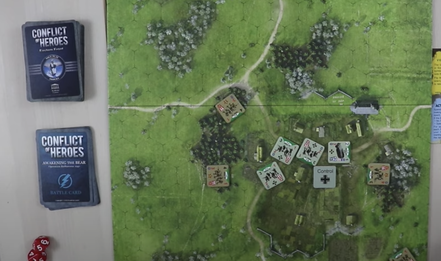 Overall Thoughts Conflict of Heroes: Awakening the Bear features one of the coolest AI opponents I have ever encountered. I love the card system—not only is it easy to use, but it is challenging. In this game, the AI will make use of cover, flank you, and generally make smart decisions. The designers have also created ways for the enemy to have hidden units by placing "rumored" enemies on the board that may or may not be real. I am truly delighted by what this system has to offer. If you're looking for an introduction to war games and want a good place to start, then Awakening the Bear might be a particularly good choice for you. The rulebook is long, but clear and full of excellent examples. The AI is also streamlined, and not as intimidating as some of the flow charts you may encounter later in your wargaming journey. I have one main issue with this game, which is that there are only limited solo missions in the Eastern Front box. The missions you get are entertaining, but they won't last forever, and too many of them force you to play as the Germans (I don't refuse to play Nazis in board games, but it's not exactly my favorite). It is possible to get the Firefight Generator expansion if you need more, but I really dig the official missions. There is some good news on that front, however—several more free missions were released to keep us all entertained during quarantine. I am really looking forward to trying these! One thing you should note when playing the third edition of Awakening the Bear is that your Eastern Front expansion is entirely compatible with the second printing, but has different hex numbers than 3rd ed. and makes a few references to 2nd ed. rules. This isn't a huge deal, but you will encounter some minor discrepancies when playing, so don't panic. The other thing I want to note about Awakening the Bear is not exactly a criticism, but more of an observation. If you were to take the mechanisms from Awakening the Bear and apply them to fantasy battles, battles in space, or pretty much any other conflict scenario, it wouldn't make much of a difference. I sometimes wish that weren't the case, because if I'm going to play a game where I am either the Russians or the Germans during WWII, I'd like there to be a bit more weight to my actions. This is the kind of game you play for some simple, tactical fun, not for historical depth. That said, Conflict of Heroes: Awakening the Bear is a hell of a good time, and I really enjoy playing it. Do I recommend it? Definitely. Conflict of Heroes: Awakening the Bear is a solo classic for a reason. It's also highly accessible for those who are new to war games and want to get their feet wet. Overall Rating: 4 stars 5 stars — I love it! 4 stars — I really like it. 3 stars — I like it. 2 stars — It's okay. 1 star — Meh. 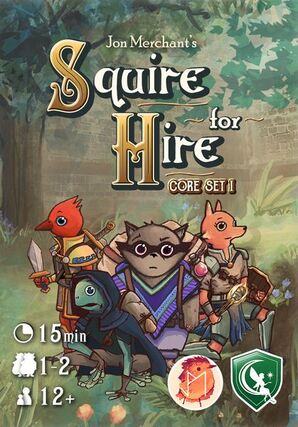 Full disclosure: I received a review copy of Squire for Hire from Letiman Games. What is this game about? Squire for Hire is a tile-laying microgame in which each player takes on the role of a squire maintaining an adventurer's inventory. This inventory, or "bag," is essentially a set of cards that players overlap strategically throughout the game. Each player gets a starting card for their "bag," and the rest form a deck of story cards, with the top two cards flipped over and placed to either side. (All of the cards are double-sided, with a story event on one side and a grid full of items on the other.) For each story card, players can choose to complete its requirements either by having enough of the right item type (weapon, magic, etc.) or by "paying" an item from their bag, i.e. covering it up with a new card. If they choose to fulfill a story card, the player will then get to choose one of two inventory cards as a reward and add it to their "bag." If a player cannot or doesn't want to meet the requirements of a story card, they are free to skip it, flipping it over into one of the inventory card piles as a potential reward for the following turn. This simple game structure quickly becomes an enjoyable spatial puzzle as players hoard as many items as possible, keep an eye on their specific scoring bonuses, and attempt to cover up junk items that will subtract points from their final score. Some items grant bonuses when adjacent to each other, but partial overlaps aren't allowed—to place a card, one complete item on that card has to overlap a card that is already in your bag. How does it play solo? Solo players can work through the story deck on their own, and only need to meet a scoring threshold. 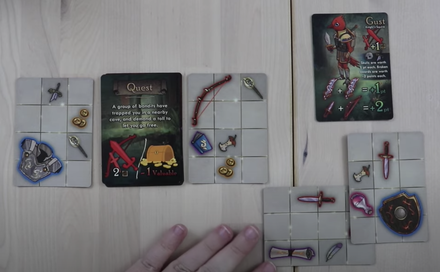 Overall Thoughts Squire for Hire is a charming game that is compact, quick to play, and enjoyable. If you're looking for a true microgame, I think that Squire for Hire fits the bill. Its footprint while in the box is so small you could slide it into a shirt pocket, and even on the table it only requires a small amount of space. The amount of time it takes to blaze through a game of Squire for Hire also makes it an ideal lunch break game. In addition to its portability and speed, Squire for Hire is also an enjoyable game. The adorable animal art is delightful and makes the game more fun to play. And Squire for Hire is legitimately a fun spatial puzzle, with just enough choices to keep you engaged. I liked taking stock of my options each turn, choosing whether to fulfill the requirements of a story card, which reward to take, and what to prioritize when placing new cards in my bag. However, Squire for Hire is not a perfect game. The ruleset as initially printed is all crammed onto the inside of the box, which on the one hand is brilliant—small footprint! But on the other, it ends up feeling like crucial information has been left out, especially for solo players. (Squire for Hire is being reprinted, and it looks like this issue will be fixed in the new edition.) There are also some small pacing issues in the game, particularly if you draw too many unfortunate story cards in a row. If you have to keep passing on events that emerge from the deck, you aren't adding to your bag either to score more points or to prepare for story cards to come, a pattern that can leave you feeling a little stuck. Overall, though, Squire for Hire is a charming microgame. It's not going to unseat Sprawlopolis or Orchard for me, but it's a welcome addition to my repertoire of small, quick games. Do I recommend it? If you love microgames, yes. Squire for Hire is quick, fun, and inexpensive—a pledge for the second core set was only $9. Overall Rating: 3.5 stars 5 stars — I love it! 4 stars — I really like it. 3 stars — I like it. 2 stars — It's okay. 1 star — Meh.. 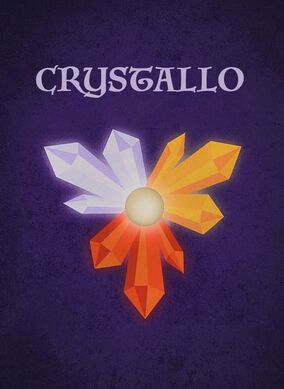 Full disclosure: Zafty Games provided me with a review copy of Crystallo. What is this game about? Crystallo is an abstract solitaire card game divided into two parts. In the first, you rescue six mythical creatures by drawing and placing your cards in ways that activate orbs required to free them. In the second, you will trap the evil Black Dragon who captured those creatures in the first place. To do it, you will have a hand of cards that you arrange using the same orb-activating principles. If you run out of cards in the first part of the game, you lose. If you fail to arrange your cards successfully when going up against the Black Dragon, you also lose. Each card you draw in Crystallo will contain a different combination of orbs and crystals. The orbs will be different colors, depending on which sort of creature they are able to set free. The crystals can be one of three possible colors, as well as one of three possible shapes. To activate an orb, you will need to surround it with one of the accepted combinations of crystals—all the same shape or color, or all different shapes and colors. Beyond that, you have a lot of freedom when it comes to card placement—cards can be adjacent to each other, they can overlap, and they can be placed horizontally or vertically. Orbs will be your priority in this game, but there are also treasures to distract you. If you collect sets of different types of treasures, you will get a cool bonus. But at what cost? How does it play solo? Crystallo is a solo game. Woohoo! 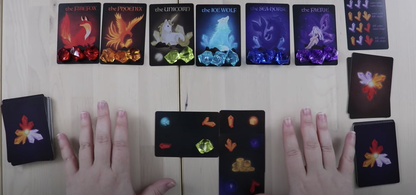 Overall Thoughts Overall, Crystallo is a charming solo puzzle that I enjoy. It is not necessarily one for the ages, but it's a nice quick game to add to the work night rotation. First, the good. Crystallo is a fun puzzle, and one that takes a bit of getting used to. It's not uncommon to have to play it a few times before getting past the first part of the game and getting a chance to confront the Black Dragon. There are fun decisions to make when it comes to how to place each card, which treasure sets to pursue, and which cards it is safe to cover up as you attempt to activate the correct orbs. I also liked that the game takes place in two phases, especially because the second phase plays with the mechanisms of the first in fun ways. While the first phase of the game is very tactical because you draw and place one card at a time, the second phase uses the same placement concepts you've learned, but allows you to see and arrange the cards in advance. It's a fun way to push skills that you've already developed in earlier turns of the game. However, Crystallo is not a perfect game. Once you grow accustomed to how it works, you'll find that you usually win, and that the puzzle is no longer quite as satisfying. It might be fun to pull the game back out after I've let it cool off for a while, but I haven't gotten to that point yet. I also have some quibbles with the components. Crystallo comes in a bag that initially looks luxurious, but is made of a fuzzy fabric that is wearing quickly. My tuck box and cards have also been very quick to show wear. The symbols on the cards themselves are pleasingly colorful, and the crystals you place to activate the orbs are enticingly shiny, which somehow makes the production seem both striking and a little underdone. Crystallo is also in competition with other small-box games, and there are some tremendous ones on the market these days. My favorite small game is still Sprawlopolis, but I am also very fond of Orchard, as well as other solo games that made a splash on the print-and-play circuit such as Mr. Cabbagehead's Garden. Crystallo is good fun, but it isn't best in class. Not only does the gameplay wear out a little too quickly, but Crystallo is not as efficient as a small box or backpack game. Its packaging is compact, but once you get it out, the game is a huge table hog, which is a real threat to its portability. Do I recommend it? If you're looking for another solo game in a small package for your rotation, then yes. Crystallo might be for you. This is especially true if you like PnP games, because you can download and build this one yourself. Overall Rating: 3.5 stars 5 stars – I love it! 4 stars – I really like it. 3 stars – I like it. 2 stars – It's okay. 1 star – Meh. 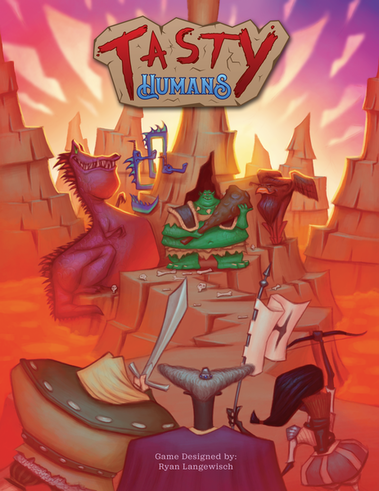 Full Disclosure: I received a review copy of Tasty Humans from Pangea Games. What is this game about? Tasty Humans is a game in which you (and fellow players, if you want them) take on the roles of monsters who can't wait for conquering heroes to arrive—so that they can eat them. Throughout the game, you'll be filling up your monster's stomach with parts of those heroes (hands, feet, helmets...), with as much attention to your particular appetites as possible. The winner of the game will score the most victory points based on how well they filled up their monster's stomach according to their individual taste. In Tasty Humans, your stomach is a grid, and the hero parts you consume fall into your belly in Tetris-like configurations. Depending on which monster you play, you will want to create different patterns of adventurer body parts in order to score bonus points. You'll also pick up bonus scoring tiles throughout the game that give you further opportunities to score. The game ends when the first monster's stomach is full. On each of your turns, you will choose an advancing hero card from a 3x3 grid. Each card will tell you the arrangement of tiles you can drop into your stomach, as well as the type of hero you're eating. Some, such as Clerics or Wizards, have special abilities that allow you to heal wounds or adjust the placement of tiles in your belly. If you choose to eat a hero who is adjacent to a warrior, or two spaces from an archer, then your monster will have to eat wound tokens in addition to the tasty human they chose as a snack. No one injury is going to cost you the game, but if you accumulate too many, they can affect your score, either by interrupting your plans for other tiles or by costing you points because one or more wounds end up placed next to each other. In both single and multiplayer gameplay, you'll also need to pay attention to which heroes you and your opponent are drafting. Aside from the hero classes and important tile configurations on each card, some cards feature crown symbols. These symbols allow player who has collected the most of them to have first choice of bonus tiles between rounds, which can affect your final score. How does it play solo? Tasty Humans comes with rules that allow you to play against an automated opponent who drafts cards from the market, blocks you from getting bonus tiles, and scores based on the cards it has picked up throughout the game. At the end, the AI will score based on the class types of heroes it has collected (don't let it get too many of the same type!), as well as the number of body part tiles depicted across all cards it has collected. So as you play, you will get a chance to hate draft in an attempt to keep the AI at bay. You can also control the AI's difficulty level by allowing it to start the game with more or fewer hero cards. Overall Thoughts Tasty Humans is a game I wanted to like a lot more than I ultimately did. I enjoy spatial puzzles, especially ones with echoes of Tetris. In Tasty Humans, it's fun to try to figure out where to drop new tiles, to rotate hero cards back and forth, and to decide which scoring bonuses you want to go for. This game also adds a fun twist, as the monster parts you drop into your stomach don't always maintain the shape printed on the card you draft—tiles can "break off" and drop to the bottom of the column you put them in, without leaving gaps. This adds an extra element of planning and spatial thinking that I did enjoy. The AI for this game also did a good job of helping you to enjoy the same aspects of gameplay that you would in the multiplayer version of the game, including the need to scrap for cards you want to draft and to try to block the AI from getting too many beneficial cards. However, Tasty Humans does not play as smoothly or as quickly as I would like. The game feels clunky, especially as you arrange all of the tiny little hero tiles so they can be placed in your monster's stomach. Some aspects of solo play are also a bit finicky—you and the AI pass the first player token back and forth throughout each turn, and whether the AI clears out a row or a column of adventurers during its turn alternates depending on who has the first player token. Little rules like this feel arbitrary and unintuitive, and that made it hard for me to stay in the flow of the game. I typically do not mind finicky games with a lot of components, but Tasty Humans is a light game, and it feels like it should be a lot snappier than it is. It's not bad, but it also isn't all that exciting. I didn't find myself on edge with anticipation between turns, and did not feel the urge to set up and play again when I finished a game. If I want that Tetris vibe, I'd rather just play another game of Cartographers. Do I recommend it? Maybe, if you really love polyominoes games and are dying to add yet another to your collection. Overall Rating: 3 stars Rating Scale: 5 stars – I love it! 4 stars – I really like it. 3 stars – I like it. 2 stars – It's okay. 1 star – Meh. 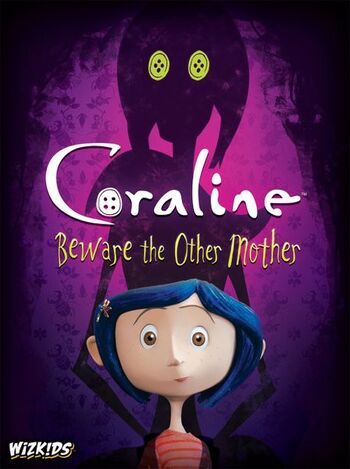 Full disclosure: WizKids sent me a review copy of Coraline. What is this game about? Coraline is a cooperative board game based on the movie version of Neil Gaiman's book. The game takes place at the climax of the film, when Coraline is trying to rescue her parents, escape the Beldam, and leave the Other World for good. You (and the other players, if you want those) represent Ghost Children who are helping Coraline in her quest. To win, Coraline must collect specific items from around the Other World version of her home. Then Coraline has to get back to the living room, and you have to play a card that allows you to win the game. On each turn, you will play one Coraline card from your hand, and do whatever the text on the card allows you to do. This can include revealing hidden items, moving Coraline, or bringing helpful characters from the film onto the board. (At the beginning, it's just Coraline and the Beldam.) After your turn, the Beldam gets to play a card from the Beldam deck, which means something bad is going to happen. The Beldam will essentially chase Coraline around the board, cause her to drop items, make other types of trouble, and advance the moon deck. The moon deck is one of the game's timers. You can lose the game either by running out of Coraline or Beldam cards, or by failing to find all of the required items before the moon deck fully advances. How does it play solo? Coraline is a cooperative game that largely plays the same at any player count. The main difference for you as a solo player is that you'll hold more cards in your hand. Overall Thoughts Coraline is an exciting theme, but this board game doesn't live up to the excitement of its source material. It might make a nice introductory cooperative game for younger players, or for players who love the theme. Its turn structure is very straightforward, which ought to make the game fairly accessible. The game also scales nicely, which means you don't have to change much between solo and multiplayer games. However, Coraline does not particularly capture its exciting theme. The game itself is so simple that there may not be much do it in the long run. You don't really feel like you're in desperate flight from the Beldam, either through the actions you take in the game or through the card art, which is shockingly repetitive and plain. There are very few stills from the movie, which I found disappointing given how great the film's aesthetic is. I also don't love that the game is so card driven that you can't do much without the right cards. This not only limits your in-game actions in strange ways, but leads to cards that contain a lot of text—a possible barrier to entry for younger people who might otherwise be a perfect audience for Coraline. You can pull off some cool combos and strategies with the cards, but overall I don't feel that they offer fully satisfying gameplay. Do I recommend it? Generally no. However, if you absolutely love Coraline, or have a game group for which this would be a great introductory game choice, then you might be its target audience. Overall Rating: 2.5 stars Rating Scale: 5 stars — I love it! 4 stars — I really like it. 3 stars — I like it. 2 stars — It's okay. 1 star — Meh.  What is this game about? Urbion is the second game in Shadi Torbey's Oniverse series, and it's woefully out of print. Unlike Onirim and Sylvion, as well as all the other Oniverse games in circulation, Urbion has not received the deluxe treatment from Z-Man. The object of Urbion is to bring balance to each of the twelve cities in the game before your deck of cards runs out. These are cities of dreams, which means they are inhabited by both pleasant dreams and terrifying nightmares. Essentially, your goal is to place bad dream cards on one side of your city cards, place good dreams on the other, and perform balance checks to claim cities when they are in equilibrium. (The original name of this game was, in fact, Equilibrion.) However, it won't be as simple as that. Each turn, you will look at your hand of cards and play one. You'll have a mix of good and bad dreams, each with different numerical values from one to four. Your first option is to place a dream next to one of the city cards currently available (you can work on four at a time). You'll need to pay attention to the symbols on your dream and city cards, because they need to match. Alternatively, you can play a card to the discard pile. Discarding a card allows you to manipulate dreams already in play—as well as to bend placement rules a bit, which is a key ability in the fight for balance. The discard action also allows you to perform a balance check, which you'll need to do to collect cities. If you can bring all four cities into equilibrium and then do a balance check, you'll score an extra city card, so it can be very tempting to wait. Don't expect to go about your business uninterrupted, however—there are Chaos cards in your dream deck, and they don't want you to succeed in your task. When they appear, they will force you to make unpleasant choices that push your cities out of balance or cause you to discard dream cards. And because your deck is your timer, you don't want to lose too many. How does it play solo? Like its other Oniverse siblings, Urbion is technically for 1–2 players, but I really view it as a solo game. Overall Thoughts Urbion is, like all of the Oniverse games released to date, a good, enjoyable solo game. The turn structure is simple, but in-game decisions can be complicated, especially when choosing how to handle a chaos card. It's a fun puzzle to decide how to distribute your dream cards, and how to manipulate them to bring cities into balance. And I absolutely love the temptation to wait to perform a balance check, knowing that if you can bring all four cities into balance at once, the rewards are big—but also that yet another chaos card might be right around the corner. I find that the game gets better after a few plays, when I've gotten familiar with the contents of the deck again and have a sense of what might be left in there when I'm deciding what to discard. That said, Urbion is not a perfect game. Like its predecessor, Onirim, much of the game will depend on luck of the draw, and it's possible to have a bad run of cards that causes you to lose the game. It also feels like there is a bit less you can do in Urbion to mitigate your luck. In Onirim you might be able to use a Key to dispel a nightmare card, but in Urbion a chaos card will pretty much wreck you no matter what. My other quibble is with Urbion's graphic design. I love the art of the Oniverse, and Urbion is no different. However, the symbols on the dream and city cards are bland, and tend to blend into the colorful card art around them in a way that makes them easy to miss when you're just excited about playing a dream card. Do I recommend it? If you find an affordable copy, or if it comes back into print, then yes. But if you're feeling FOMO and a strong desire to complete your Oniverse collection, take a step back. This is a good game, but there are a lot of very good small card games you can get for a reasonable price. If you want to know how I feel about Urbion in comparison with other games in the Oniverse series, Jason Perez from ENGN and I ranked them in this video. Overall Rating: 3.5 stars Rating Scale: 5 stars — I love it! 4 stars — I really like it. 3 stars — I like it. 2 stars — It's okay. 1 star — Meh. 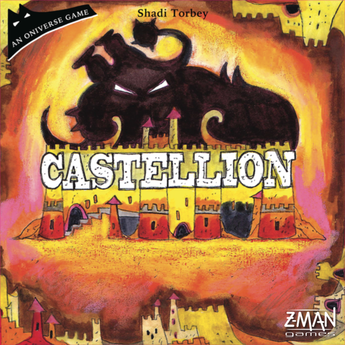 What is this game about? Castellion is a game set in Shadi Torbey's Oniverse. It's a tile-laying game in which you are building a castle, but not just any castle—you're in a race against the clock to create different formations of tiles before your fortress is tested by the enemy. Over the course of three different stages, you must create groups of the same type of tile (pyros, jugglers, chameleons, seers), arranged in either rows, columns, or squares, all within a castle that has a 6x6 limit. Although there is a simple, introductory version of the game, the regular and advanced games are where the excitement really starts. All games will involve three "tests," or sets of tile formations that you need to create within your castle. On each turn, you draw one tile and make a decision about it: either place it in your castle, or discard it and potentially use its power. All tiles will have a creature type (pyros, jugglers, chameleons, seers) and a shape (square, circle, or triangle). While you want to place matching creatures next to each other, there are further placement limitations based on shape. If a tile isn't working for you at the moment, you can discard it. Some tiles, when discarded, allow you to see into the future of your draw pile, others allow you to relocate tiles within our castle, and still others allow you to mine your discard pile for just the right piece. Many tile powers also allow you to disregard initial placement rules, which lets you manipulate your castle even more. However, you don't have all the time in the world to build your castle exactly the way you want it. Every so often, you will draw a traitor tile and have to decide what to do. Traitor tiles look like melting clocks, and their main purpose is to advance the game's timer—once you have placed a certain number of traitor tiles on your current test card, it is time to see whether you passed—and if you have failed to create the correct formations within your castle, you lose the game. There are, however, a few ways to stave off the inevitable test. Some traitor tiles have a black border, which means you cannot avoid them. But the ones without can be discarded, for a price. To get rid of them, you'll need to also destroy some of the tiles within your own castle. This can be a good way to clear out obsolete structures between test cards, but it can also be devastating. To avoid the possibility of drawing a traitor altogether, you can draw from the "safe" pile, but there is only a limited number of tiles in it, and you'll want to save them for a key moment. How does it play solo? Castellion is technically for 1–2 players, but I really think of it as a solo game. Enjoy it, solo squad! Overall Thoughts Castellion is a game that I generally like, but it's not my favorite in the Oniverse. (If you want to know where they all rank for me, you can check out this video I made with Jason Perez from Every Night is Game Night). I really enjoy several aspects of Castellion's gameplay, especially the way you can break the game by learning how to make the most of tile manipulation powers. In the "normal" version of the game, you can use tile powers by discarding them. In the advanced version of the game, you can access bigger powers by completing tile formations within your castle. With a little creativity, even destructive events like cannibalizing your castle to discard a traitor tile can be helpful and even fun. Learning how to both complete the spatial puzzle of Castellion and to make the most of tile powers is the absolute best part of the game. However, my delight in breaking the game is mirrored by my irritation with the placement rules in general. Once you learn the game, everything is fine, but Castellion comes with tile placement rules that don't always feel consistent. You can put pretty much anything in your foundation row of your castle, without regard for the shapes on the tiles, even though you can't normally place a tile adjacent to one with the same shape (circle, square, triangle). Once you leave that base level, however, the placement rules are in effect. While this makes sense intellectually, it gives me mixed messages visually, which sometimes breaks the "flow" of the game for me. Tile powers can also allow you to break the rules, and I often find myself wondering if I placed a tile illegally or if I used a tile power to get away with it. Also, if you're bothered by back luck in general, you should know that sometimes you just get a lot of traitor tiles at a bad time and lose the game. Castellion plays so quickly that this doesn't bother me too much, but you should be aware! Do I recommend it? Yes. I generally recommend all Oniverse games, and this one offers an interesting puzzle that is usually rewarding. Overall rating: 3.5 stars Rating Scale: 5 stars - I love it! 4 stars - I really like it. 3 stars - I like it. 2 stars - It's okay. 1 star - Meh. 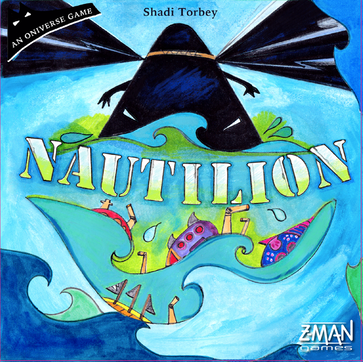 What is this game about? Nautilion is an Oniverse game, and it is Shady Torbey's attempt to make roll and move into an interesting board game mechanism. In Nautilion, you are in a race against the Phantom, an evil ship that is headed towards your happy island home. Your goal is to gather a complete crew and reach the Abyss to confront evil before the enemy reaches your island. You and Phantom will even pass each other on the way! To set up the game, you place crew tokens to form a path from your island to the Abyss. On each turn, you will roll three dice, and you will assign one to yourself, one to the Phantom, and one to a more distant evil called the Dark House. You and the Phantom will each move the number of pips on your assigned dice. You'll have a chance to either hire the crew you land on or convert it into a token to use later. These tokens are typically used on spells that allow you to manipulate the dice or the path ahead of you to get the crew members you need. When the Phantom moves, it will gobble up whatever potential crew member it lands on, removing it from the game. And if you assign a die with a value of 3 or 4 to the Dark House, it will either consume one of your tokens or remove a crew member from your game board. You will either make it to the Abyss with a complete crew before the Phantom arrives in your homeland, or you lose the game. To add to the challenge, you can't just hire any old crew member—you need to collect members 1–9, and once you have placed someone on your player mat, you can only put new crew in adjoining spaces. There are several different ship boards you can play with, some of which are more challenging than others. Nautilion also comes with a number of expansions to enhance the base game. You will end up consistently playing with the Mages, who add another element to your crew collection efforts but who also help you with their magic. The others add fun challenges such as a reef that impedes movement, or "mercenaries" who allow you and the Phantom to fight it out when you meet partway across the sea. You can also give yourself and the Dark House special powers that change the game in interesting ways. How does it pay solo? Nautilion is technically for 1–2 players, but it's very much designed for solo play. Enjoy! Overall Thoughts Shady Torbey designed Nautilion as a way to make roll and move into something fun, and I would say that he has succeeded. Depending on what you roll, deciding what dice to assign to whom can be surprisingly nerve wracking. If you move too conservatively, the Phantom might end up making bigger moves and beating you to its goal space. But if you assign high-value dice to yourself, you might end up skipping over crew members you really need. And you certainly don't want to assign high-value dice to the Dark House, especially if you're at the point where it will force you to lose crew members. Nautilion is also very easy to learn and quick to play, which makes it ideal for a relaxing afternoon or evening of solo gaming. While the base game will quickly become a bit vanilla, the expansions—particularly Mages—are worthy additions to the game that make it more interesting. A quick word of warning, though: Nautilion does involve some interesting decisions, but it is still a dice game, and it's possible to get very unlucky. If you're thinking about picking it up, be aware that luck will be a major factor in the game. My main quibble with Nautilion, however, is the fact that you make a path out of the crew tokens instead of having an actual game board. Chunks of your path will disappear throughout the game as both you and the Phantom pick up crew tokens, and because your path will curve, it's possible to get mixed up, especially if you're as messy as I am. (No beautiful, perfectly-aligned spiral pathways for me!) All those separate crew tokens also mean that Nautilion is mildly annoying to set up, which makes me less likely to play it multiple times in a row. Do I recommend it? If you're looking for an interesting small box solitaire game, then yes! You really can't go wrong with the Oniverse. Overall Rating: 3.5 stars Rating Scale: 5 stars — I love it! 4 stars — I really like it. 3 stars — I like it. 2 stars — It's okay. 1 star — Meh. |
AuthorMy name is Liz Davidson, and I play solo board games. A lot of solo board games... Archives
August 2021
Categories
All
|
 RSS Feed
RSS Feed